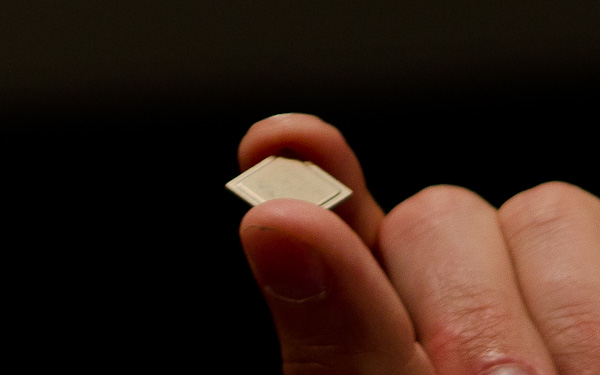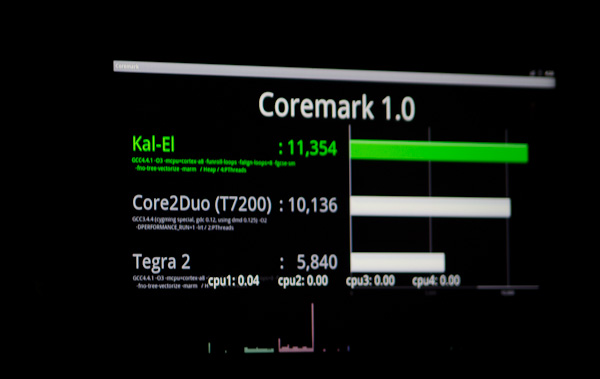NVIDIA's Project Kal-El: Quad-Core A9s Coming to Smartphones/Tablets This Year
by Anand Lal Shimpi on February 15, 2011 9:05 PM ESTFinal Words
The first thing everyone at NVIDIA asked me after I saw Kal-El running was an eager and expected: "well, what did you think?"
On the one hand, we have a clear underdog in the SoC space demonstrating a brand new chip just 12 days after getting it back from the fab. It's functional, it can render 3D games, it can decode high bitrate video and it runs Android today. The word impressive is insufficient to convey the magnitude of what I just described, particularly in the SoC space.
On the other hand, it's still just an announcement. It wasn't too long ago that NVIDIA was struggling to name a single design win. The recent success with LG, Motorola and Samsung is awesome, but it isn't a guarantee of what's to come. That being said, the handset vendors and carriers clearly take NVIDIA seriously today and they would be foolish not to consider Kal-El as it'll be the quickest way to get to quad-core in an Android phone.
Architecturally, Kal-El isn't a huge departure from what we currently have today with Tegra 2. NVIDIA claims a 5x performance improvement over Tegra 2 however that seems a bit optimistic. The 5x gains appear to be from combining the 2x theoretical gain from 2 to 4 cores plus a 3x gain from the new GPU. NVIDIA claims that this is enough to put Kal-El above a Core 2 Duo clocked at 2GHz (see the test results below), however the NVIDIA generated scores seem suspect not to mention that Coremark isn't representative of the sort of workload you'd see on a smartphone/tablet.
If NVIDIA can increase clock speeds a bit we'll see better performance than Tegra 2 on lightly threaded workloads, but I'm not convinced of the gains to be had in single-tasking workloads from four cores in a smartphone/tablet. The bigger gains over Tegra 2 will likely come from any improvements to the memory controller as well as the faster GPU. This being said, NVIDIA does believe that even web page rendering can benefit significantly from a quad-core CPU so I could be very well proven wrong once devices are out in the wild.
If NVIDIA can secure significant design wins with Kal-El based tablets in August of this year and smartphones in Q4 I will be beyond impressed. NVIDIA gets major points for putting on good demos of working silicon today but in this business you need to have devices. For now we play the waiting game. I suspect if you're not taking NVIDIA seriously at this point, you really should be.












76 Comments
View All Comments
jjj - Tuesday, February 15, 2011 - link
does this " The architecture will first ship in a quad-core, 40nm version" mean Kal-El will get a 28 nm version too?softdrinkviking - Wednesday, February 16, 2011 - link
I think the assumption is that a future iteration of the architecture introduced with Kal-El will be a die shrink. (probably the 2x one that will be implemented in 2012)At least that is what I am assuming until Nvidia proves me wrong.
michael2k - Tuesday, February 15, 2011 - link
Even if they can't sustain it, I love that they're trying. Is this the powerhouse behind the NGP?nafhan - Wednesday, February 16, 2011 - link
No, the NGP sounds like it'll be using an SGX GPU. So, that means it'll probably use Samsung or TI.Lucian Armasu - Wednesday, February 16, 2011 - link
The only other company that has announced a quad core chip for this year is Freescale. I believe they have a 1 Ghz quad core Cortex A9 chip.dleonseng - Tuesday, February 15, 2011 - link
first paragraph:"...NVIDIA may not have the entire market but it has enough of it to be take{N} seriously."
NCM - Wednesday, February 16, 2011 - link
Re "...are simply due to learnings it had in the design of Tegra 2s..." (second page)"Learning" means the process of acquiring knowledge, not the things one has learned; it doesn't have a plural form.
Instead try: "...are simply due to things it learned in the design of Tegra 2..."
DarkUltra - Tuesday, February 15, 2011 - link
Who cares about four cores? I want Android UI running on the GPU. Most people who see an Android phone will immediately do two things: swipe through home screens and scroll through the app list. If they see lag and choppiness they inevitably compare to the iPhone and assume that the phone as a whole is not as fast and responsive; end-of-story for them.The restrictions of the iphone and Apples iTunes lock-in barely makes it worth it.
A5 - Tuesday, February 15, 2011 - link
Honeycomb supposedly helps with that and presumably Tegra 3 will be running that or Ice Cream.dcollins - Wednesday, February 16, 2011 - link
Isn't Android 2.3 GPU accelerated?Also, part of the problem is the carriers software doesn't have great performance. My Droid 2 is running Liberty 1.5 and the home screens, app drawer, and contacts all scroll smoothly. Not so with the stock ROM, which stuttered a lot and got slower over time. I suggest anyone with a Droid 2 or Droid X check out Liberty.